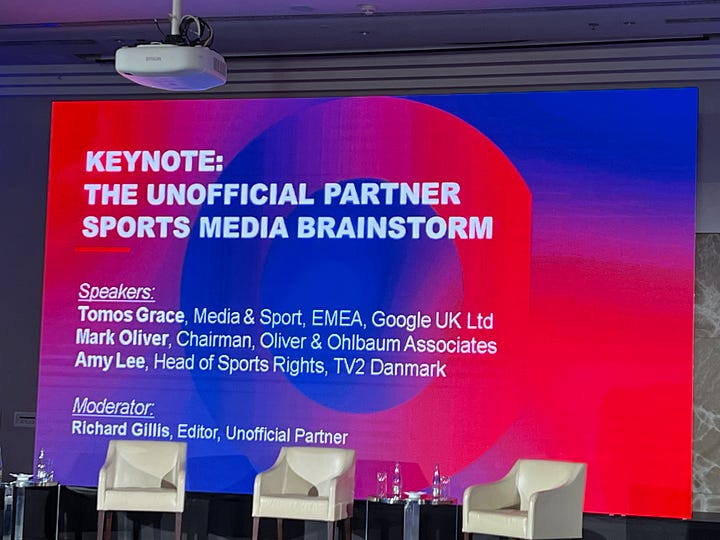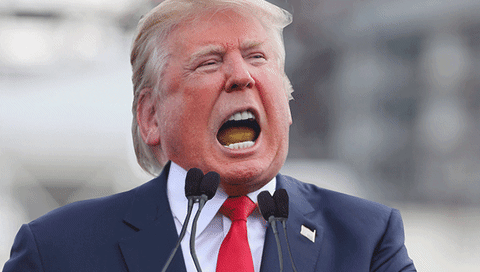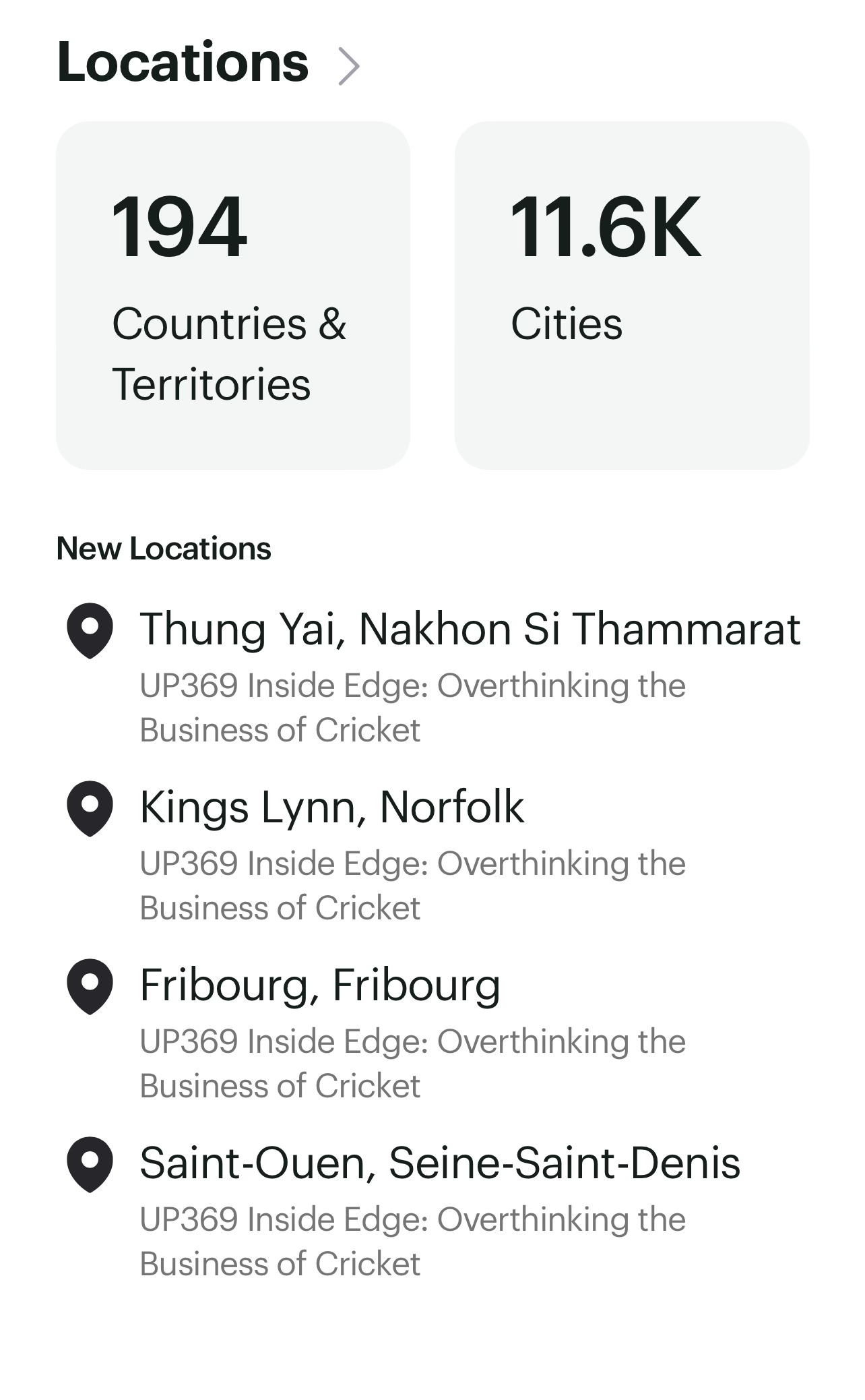The MAGA Club World Cup; UP Live; States of Play; Reimagining Rugby League, pt2; Great knocks in empty stadiums; Inside Edge, Wedge Issues and podcast verticals; Twenty20-fication
Overthinking the sports business, for money
The MAGA Club World Cup
Just off stage from this morning’s live podcast recording at the EBU Annual Assembly in a sunny Bratislava.


Guests:
Mark Oliver, Oliver and Ohlbaum
Amy Lee, TV2 Denmark, EBU Member
Tomos Grace - YouTube
The Club World Cup moment
As I was prepping for the above session, I watched this clip:
A power crazed ego maniac. And Donald Trump.
So enamoured was Trump with the sparkly gold Tiffany trophy he’s kept it in the Oval Office, where it now forms the backdrop of his zone filling daily soap opera from invading Greenland to delaying global trade war.
So we used FIFA Club World Cup as our way in to ask, what is media strategy now?
Having coughed a billion for the rights (insert conspiracy theory here), DAZN is busy punting the rights around to many of the people in our audience in Bratislava - the EBU’s constituency of free to air public broadcasters.
Elsewhere, UEFA is selling the Women's UEFA Champions League rights, another nascent property at a critical stage in its commercial development.
Session Provocation:
We asked the esteemed panel: if you were DAZN/FIFA, what would you do?
This is a proxy for the relationship between sports rights holders of all types charged with building value in new event formats and media entertainment products.
How does FIFA view the role of Europe's premier publicly funded television platforms in building value for their new product?
What is the role of YouTube in their thinking?
What are the lessons of the 2023 FIFA Women's World Cup process?
With a glut of new sport-as-entertainment products coming to market regularly, there's talk of disruption across every major sport; A LIV Golf for Everything...Baller, King's League, Unrivalled, League One Volleyball (LOVB)...there’s about 40 new things seeking an audience this year alone.
Given that job what would you do?
Answer in next week’s podcast.
The most influential person in Premier League history
We had Miguel Delaney, chief football writer for The Independent on the podcast this week, talking about his book States of Play: How Sportswashing Took Over Football.
He tells me that the paperback is getting an extra chapter, focused on Trump’s use of the FIFA World Cup in 2026.
The origin story of the book however is Abramovich, who changed the game and became the playbook for much that followed.
The flywheel was set.
The podcast is here:
Is this what IMG reimagined?
Rugby League is one of those sports I don’t watch but am glad exists.
I’ve got a romantic attachment to it, entirely built by free to air broadcast television (BBC Grandstand).
We were forced to watch it as children because to not watch it meant having to do our homework, see also Songs of Praise and The World At War.
Because we lived in the south I didn’t make the assumed sports marketing journey from viewer to participant. It wasn’t an option even if I wanted to, which I didn’t particularly - today we’d blame the governing body for not engaging with me, using terms like funnel conversation and mental and physical availability.
Two UP podcasts have talked in depth on the sport.
The first was with Jamie Peacock, legendary player.
The second was with Adam Kelly, president of IMG, at the time of ‘the great reimagining’ - a 12 year deal that promised to well, reimagine the sport in England.
Someone sent me the story below asking whether this is part of that.
I don’t know tbh. But someone will tell me I’m sure.
See previous: What’s the difference between IMG and P/E?
UP’s vertical strategy
This week we launched a new business of cricket podcast called Inside Edge.
This joins other sports verticals in the UP pod portfolio, such as Expected Goals (women’s football) and Wedge Issues (golf).
Others may follow.
What I like about these sport specific shows is their ability to reach adjacent audiences who want the Unofficial Partner approach applied to their sport.
The early evidence is promising:
Over the past six years we developed individual IP strands covering sports business themes.
These include The Bundle (media), The Buy Side (marketing and sponsorship), Other People’s Money (finance), The Big Idea (creative).
Podcasts are great at sensing demand quickly.
If there’s an audience, we can service that niche with live events big and small.
For now, Inside Edge will sit within the Unofficial Partner podcast stream, making it easy to find.
Here’s the first episode, with co-host Mike Jakeman, whose work I’ve long admired in The Economist and his excellent book, Saving the Test.
Twernty20fication - the most misleading case study in sport
Why and why now?
That’s a question we ask in this first setup episode.
My line is that cricket contains many of the big themes we discuss across the sports business. And for a sport that’s dismissed as old fashioned, it has long been oddly fashion forward.
T20 is the most successful commercial iteration of a new sporting format.
But what are the right lessons to be drawn from it?
Why has it worked and Rugby Sevens/short form golf/tennis/a.nother sport not worked?
What are the lessons for the above mentioned ‘glut of 21st century digital first sports properties’ seeking an audience and TV rights money, not necessarily in that order.
Is T20 about format or economics? Is it about cricket or India?
Why Now?
The Hundred has changed the landscape.
We need to follow the still ongoing franchise auction closely.
It contains a load of strands that our audience will want to be developed further.
It’s all in there: The thrill of disruption; Sport as entertainment; new audience v traditional values; private money v public funded monopoly; player as brand; instinct v data.
How it’s going
A year or so ago we had Kumar Sangakkara on the podcast, one of the all time great players and the director of cricket for Rajasthan Royals.
Have a look at this next clip, filmed at the IPL auction a couple of years ago.
Note the sport-as-consultancy language and demeanour of the C-Suite, the desperation to sign Harry Brook and how the whole thing could be a scene from Moneyball.
Now put yourself in Harry Brook’s shoes for a moment, watching this.
You’re the hottest young player in the world.
Very rich men are thirsting to acquire you.
And unlike your predecessors, you have real leverage.
A whole different career presents itself.
Am I an England player who plays franchise cricket, or a franchise player who’s hired by England?
And then think of the implications of those decisions on your current employer, the ECB.
Think of how little control the board now has over its most valuable product - the England team.
Extend this question to the people making decisions as to whether to invest in England cricket - Sky and the other broadcasters, who pay millions for the implied promise that Harry Brook will turn up fit and eager, in all three forms of the game.
Starts to look a bit shaky doesn’t it.
That’s what the IPL has done.
It has radically altered the power balance in one of the world’s major sports.
Given that backdrop, what now?
This is where we started in this week’s pod.
The Harry Brook Question has a broader relevance.
It relates to the more fundamental issue of professional sport’s relationship with money, and the IPL is the definitive case study.
The Cream v The Slog
CVC, Bridgepoint, Bain, Clearlake, 777…all of ‘em… they’re only here for the money.
They’re here for Harry Brook, media rights sales estimates and medium term franchise valuations.
The Cream.
They ain’t here for the hard graft of building value in sport over the long term.
The massive physical, human and financial infrastructure required to build the next Harry Brook.
Let’s call it The Slog.
The Slog is left to governing bodies, backed by tax money and volunteers.
This is why the IPL is so important.
It’s not about competition format, fan engagement or the Bollywood event experience: That’s just sports industry noise.
It’s because the IPL is further ahead in the big question: how do we get the best of all worlds? The Cream and The Slog.
I’ve not heard someone articulate the challenge of the next phase quite so eloquently as Sangakkara did this week.
This first part is a good framing of where we are:
Sangakkara: The IPL has broken the monopoly hold that home boards have had with their central contracts in terms of really restraining and restricting the player's ability to go and play in franchise cricket. (Even though still they require an N O C or a no objection certificate from their home boards to participate).
Then he goes further.
Sangakkara: There could also be the opportunity for home boards, even the ICC, to bring these big franchise owners into the fold to really also be part of the solution. Is there a way to get rid of central contracts and to actually pass that on to franchises? Will that allow a partnership to form where franchises are brought into support grassroots cricket and counties and clubs and not just take the profits off the top of the franchise tournaments, but actually commit to supporting grassroot cricket.
Sangakkara was one of the all time great players.
He was the first non-British president of the MCC.
His Cowdrey Lecture remains one of the bravest and most important speeches in recent years.
Now he’s director of cricket for an IPL franchise.
He is exactly the person cricket needs to listen to right now.
He knows how fragile sport is.
He knows that everyone wants The Cream, from the national boards to the ICC, the franchises with their multi club ambitions.
Something’s going to have to change. And fast.
What Sangakkara’s proposing is both obvious and very radical.
It will move the game from the Victorian-era model of bilateral tours to a FIFA-like system of international tournament windows.
I think he’s right.
The greatest innings in front of empty crowds
I’m a long form snob. Test cricket is the real thing, everything else is lesser.
This is a silly position in 2025, but one I use to establish my intellectual and cultural credentials.
We got talking about popularity, crowds and media coverage.
Which got to a question, what’s the best innings you’ve seen in front of empty seats?
This is mine:
Since the podcast came out there’s been votes for Brian Lara’s record breaking 501 in front of six people and a dog at Edgbaston in 1994.
Then Tim Crow came in with two good choices from his rolodex of cricket history:
And his personal favourite, Barry Richards against Lillee, 300 in a day.
About twelve schoolkids watching. Proper cricket. None of this sport as entertainment nonsense. The sound of one man clapping as someone once put it.







